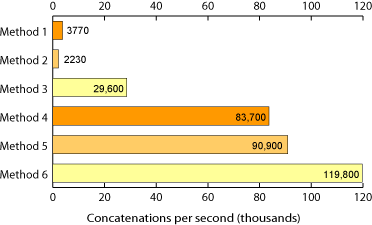Python的字符串连接与str.join的速度有多慢?我想知道+=运营商和运营商之间的速度差异''.join()那两者之间的速度比较是什么?
3 回答
大话西游666
TA贡献1817条经验 获得超14个赞
来自:高效字符串连接
方法1:
def method1(): out_str = '' for num in xrange(loop_count): out_str += 'num' return out_str
方法4:
def method4():
str_list = []
for num in xrange(loop_count):
str_list.append('num')
return ''.join(str_list)现在我意识到它们并不具有严格的代表性,并且第四种方法在迭代并加入每个项目之前附加到列表中,但这是一个公平的指示。
字符串连接比串联快得多。
为什么?字符串是不可变的,不能在适当的位置进行更改。要改变一个,需要创建一个新的表示(两者的串联)。

沧海一幻觉
TA贡献1824条经验 获得超5个赞
我的原始代码是错误的,似乎+连接通常更快(特别是在较新的硬件上使用较新版本的Python)
时间如下:
Iterations: 1,000,000
Windows 7,Core i7上的Python 3.3
String of len: 1 took: 0.5710 0.2880 secondsString of len: 4 took: 0.9480 0.5830 secondsString of len: 6 took: 1.2770 0.8130 secondsString of len: 12 took: 2.0610 1.5930 secondsString of len: 80 took: 10.5140 37.8590 secondsString of len: 222 took: 27.3400 134.7440 secondsString of len: 443 took: 52.9640 170.6440 seconds
Windows 7,Core i7上的Python 2.7
String of len: 1 took: 0.7190 0.4960 secondsString of len: 4 took: 1.0660 0.6920 secondsString of len: 6 took: 1.3300 0.8560 secondsString of len: 12 took: 1.9980 1.5330 secondsString of len: 80 took: 9.0520 25.7190 secondsString of len: 222 took: 23.1620 71.3620 secondsString of len: 443 took: 44.3620 117.1510 seconds
在Linux Mint上,Python 2.7,一些较慢的处理器
String of len: 1 took: 1.8840 1.2990 secondsString of len: 4 took: 2.8394 1.9663 secondsString of len: 6 took: 3.5177 2.4162 secondsString of len: 12 took: 5.5456 4.1695 secondsString of len: 80 took: 27.8813 19.2180 secondsString of len: 222 took: 69.5679 55.7790 secondsString of len: 443 took: 135.6101 153.8212 seconds
以下是代码:
from __future__ import print_functionimport timedef strcat(string):
newstr = ''
for char in string:
newstr += char return newstrdef listcat(string):
chars = []
for char in string:
chars.append(char)
return ''.join(chars)def test(fn, times, *args):
start = time.time()
for x in range(times):
fn(*args)
return "{:>10.4f}".format(time.time() - start)def testall():
strings = ['a', 'long', 'longer', 'a bit longer',
'''adjkrsn widn fskejwoskemwkoskdfisdfasdfjiz oijewf sdkjjka dsf sdk siasjk dfwijs''',
'''this is a really long string that's so long
it had to be triple quoted and contains lots of
superflous characters for kicks and gigles
@!#(*_#)(*$(*!#@&)(*E\xc4\x32\xff\x92\x23\xDF\xDFk^%#$!)%#^(*#''',
'''I needed another long string but this one won't have any new lines or crazy characters in it, I'm just going to type normal characters that I would usually write blah blah blah blah this is some more text hey cool what's crazy is that it looks that the str += is really close to the O(n^2) worst case performance, but it looks more like the other method increases in a perhaps linear scale? I don't know but I think this is enough text I hope.''']
for string in strings:
print("String of len:", len(string), "took:", test(listcat, 1000000, string), test(strcat, 1000000, string), "seconds")testall()
阿波罗的战车
TA贡献1862条经验 获得超6个赞
现有的答案写得非常好,研究得很好,但这是Python 3.6时代的另一个答案,因为现在我们有文字字符串插值(AKA,f-strings):
>>> import timeit>>> timeit.timeit('f\'{"a"}{"b"}{"c"}\'', number=1000000)0.14618930302094668>>> timeit.timeit('"".join(["a", "b", "c"])', number=1000000)0.23334730707574636>>> timeit.timeit('a = "a"; a += "b"; a += "c"', number=1000000)0.14985873899422586使用CPython 3.6.5在2012年Retina MacBook Pro上进行测试,其中Intel Core i7为2.3 GHz。
这绝不是任何正式的基准测试,但看起来使用f-strings与使用+=连接一样高效; 当然,任何改进的指标或建议都是受欢迎的。
添加回答
举报
0/150
提交
取消
